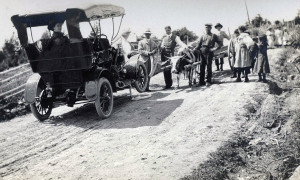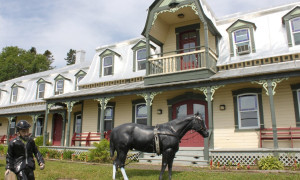Articles
Thanksgiving Day, October 18, 1900, was a beautiful autumn day in the Ottawa area. The weather was sunny but cool, with a temperature about 60 degrees Fahrenheit. The trees in the Gatineau Hills were ablaze in their autumn colours.
The word “bootlegging” apparently came into general use in the American Midwest in the 1880s. It denoted the practice of concealing flasks of illicit liquor in boot tops when going to trade with Indians.
THE GATINEAU
Toponymy is the study of place names. Herewith is a short list of Gatineau places and how they received their names…
Gatineau
The Gatineau River and the City of Gatineau were named after Nicholas Gatineau dit Duplessis, notary of Trois Rivières, Quebec. In about 1650, Gatineau tired of the hum-drum life and, wishing to return to his beloved France, turned to hunting and trapping on the Gatineau River to gather the needed cash for his voyage home. Gatineau did not realize his dream; legend tells us that he drowned in the river that now bears his name.
For over 150 years, a general store was operated by the Thomson family at the corner of Victoria and Galipeau Streets, the main east-west and north-south crossroads in the very centre of the village of Thurso. History passed by its doorstep and the news of its inhabitants could be heard within its doors.
Judge Thompson House is a superb survivor from the first half of the nineteenth century. Overlooking Gerard D. Levesque Boulevard in New Carlisle, the house dates back to c.1838 and is one of the oldest buildings on this part of the Gaspé Coast.
Building the First Metis Beach Lighthouse
In 1873, R. Cameronof Lancaster,Ontario, was given the contract to build a lighthouse at Metis. Cameronhad already built several lighthouses along the St. Lawrence near the Thousand Islands. The construction cost $3518 of which the lighting and accessories accounted for $1425. The lighthouse was built of wood and was 40 feet high. The Light tower was made of iron and 7 1/2 feet in diameter.
One of the finest examples of mid-nineteenth century architecture on the Gaspé Coast is the mansion known as Hamilton Manor.
Gaspé, the scene of many historic events across the years, witnessed dramatic events in September 1758.
The great French fortress of Louisbourg had surrendered to the British forces in August. An expedition was then organized and dispatched to Gaspé to destroy French settlements and shipping in the Gulf of St. Lawrence. Sir Charles Hardy and Brigadier-General James Wolfe were in command of the naval and military forces respectively.
In the summer of 1909, a remarkable automobile journey was made from New Carlisle to Roche Percé. It would be considered ordinary today, hardly noteworthy even if travelling in an antique car. At the time, however, it was a different matter.
Gesgapegiac is a Mi'gmaq community situated along the south Gaspé coast just east of Maria, Quebec. The place-name "Cascapedia" (as in, the world-famous Cascapedia River) is actually a derivation of the name "Gesgapegiac," which is Mi'gmaq for "last land."
Foreword:
Though the name of Frederick James Richmond continues to be recalled annually to the youth of Gaspé through the award of the Richmond scholarships, established by his brother George, the life and influence of this remarkable Gaspesian has faded with time and the passing away of those who knew him personally. Sweeping social changes have so altered the society of his native town of Gaspé that much of its earlier English heritage may soon be forgotten.
In October 1675, more than three centuries ago, Father Chrestien Le Clercq, a missionary of the Recollet or Reformed Franciscian Order of France, landed at Percé in Gaspesia.
The story of the life of Felix O’Hara and his family is linked so inextricably with the early settlement of Gaspé Basin and with events in the District of Gaspé that it is unusually significant. The following attempt at recall of the family story reflects various, widely scattered records. One vital source of information was not available – that of Church records – for Gaspé had no Protestant clergy until long after the death of Felix O’Hara in 1805.The visitor to modern Gaspé will find no civic memorial to Felix O’Hara.
Forillon has been inhabited for a long time. Nine thousand years ago, prehistoric peoples camped on the capes lining the point, the marine terraces of the Anse au Griffon Valley and Penouille Point.
For centuries, the coves and pebbled beaches of the Gaspé Cape in Petit-Gaspé had attracted the Micmacs, the first inhabitants of Gaspé, seasonal and sedentary fishers. The largest coves, such as Anse aux Sauvages, Saint-Georges Cove and Grande-Grave had villages established near them. Smaller coves welcomed family settlements.
Aviation pioneer Jacques de Lesseps, or the Comte de Lesseps, as he is often known, was the eldest son of Ferdinand de Lesseps, the French diplomat who was behind the Suez Canal.
One of the premier architectural landmarks along the south Gaspe Coast (Route 132) is the remarkable LeGrand Hotel in Port Daniel. Built in 1899 by Alfred Dumaresq LeGrand, a native of Jersey, the building is as fine an example of Second Empire architecture as one is likely to find in this part of the world.
Tears roll down Carl Bond's cheeks as he stands outside the 96-year-old general store overlooking the glittering bay where Perce Rock looms in the distance.
The door is locked, and, for the first time in 38 years, store manager Bond no longer has the key. "It's a whole lifetime all gone down to nothing," says Bond, 55, who started working here at age 16.
The Robin store - owned by Robin, Jones and Whitman, Canada's oldest retailer after the Hudson's Bay Co. - was where villagers bought everything from sugar to septic tanks, cashed their cheques and gathered for gossip.
We grew up right here in York. Oh yes, there was a number of us boys grew up here together. The Stewart boys and the Jones boys.
As young fellows in the summertime, we spent a lot of our time in the water, down there on the shores of York River. York Bay you might call it. Swimming and wading and playing down on the beach. Then we used to do work with our mother and father-sometimes a little in the garden, haymaking would come up and milking and stable work. Hunting and fishing too, every boy did that.
The publication of our book, Our Gaspé Home, Now and Forever, created a whirlwind of excitement in our halls and classrooms. It was not, however, our only triumph.

